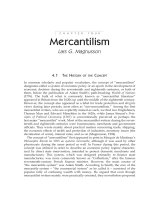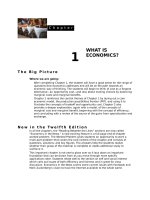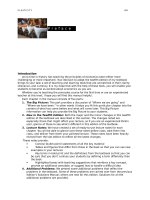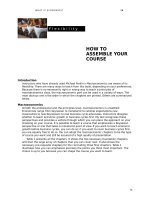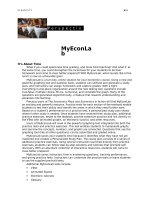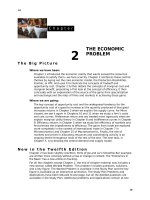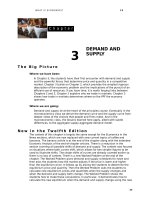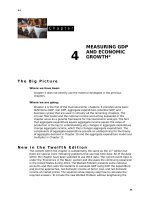Answers to review quizzes marcroeconomics 12e parkin chapter 4
Bạn đang xem bản rút gọn của tài liệu. Xem và tải ngay bản đầy đủ của tài liệu tại đây (515.63 KB, 17 trang )
W H AT I S E C O N O M I C S ?
67
4
MEASURING GDP
AND ECONOMIC
GROWTH**
Answers to the Review Quizzes
Page 124 (page 532 in Economics)
1.
Define GDP and distinguish between a final good and an intermediate good.
Provide examples.
GDP is the market value of all the final goods and services produced within a
country in a given time period. A final good or service is an item that is sold to the
final user, that is, the final consumer, government, a firm making investment, or a
foreign entity. An intermediate good or service is an item that is produced by one
firm, bought by another firm, and used as a component of a final good or service.
For instance, bread sold to a consumer is a final good, but wheat sold to a baker to
make the bread is an intermediate good. Distinguishing between final goods and
services and intermediate goods and services is important because only final
goods and services are directly included in GDP; intermediate goods must be
excluded to avoid double counting them. For example, counting the wheat that
went into the bread as well as the bread would double count the wheat—once as
wheat and once as part of the bread.
2.
Why does GDP equal aggregate income and also equal aggregate
expenditure?
GDP equals aggregate income because one way to value production is by the cost
of the factors of production employed. The cost of the factors production employed
—wages, interest, rent, and profit—equal aggregate income and therefore
aggregate income equals GDP. GDP equals aggregate expenditure because
another way to value production is by the price that buyers pay for the production
in the market. Aggregate expenditure equals the sum of consumption expenditure,
investment, government expenditure, and exports minus imports, which is the
total amount spent buying the production in the market. Therefore GDP equals
aggregate expenditure.
3.
What are the distinctions between domestic and national, and gross and net?
“Domestic” means that the production being measured is within a country no
matter by whom; “national” means that the production is produced by residents of
the nation anywhere within the world. “Gross” means before subtracting
depreciation. “Net” means after subtracting depreciation. The terms apply to
investment, business profit, and aggregate production.
67
68
Page 127 (page 535 in Economics)
1.
What is the expenditure approach to measuring GDP?
The expenditure approach measures GDP by focusing on aggregate expenditures.
Data are collected on the different components of aggregate expenditure and then
summed. Specifically, the Bureau of Economic Analysis collects data on
consumption expenditure, C, investment, I, government expenditure on goods and
services, G, and net exports, X − M. These expenditures are valued at the prices
paid for the goods and services, called the market price. GDP is then calculated as
C + I + G + X − M.
68
2.
What is the income approach to measuring GDP?
The income approach measures GDP by focusing on aggregate income. This
approach sums all the incomes paid to households by firms for the factors of
production they hire. The National Income and Product Accounts divide income into
five categories: compensation of employees; net interest; rental income; corporate
profits; and proprietors’ income. Adding these income components does not quite
equal GDP, because it values the output at factor cost rather than the market price
and omits depreciation. So, further adjustments must be made to calculate GDP:
Indirect taxes and depreciation must be added and subsidies subtracted.
3.
What adjustments must be made to total income to make it equal GDP?
Total income is net domestic product at factor cost. To convert it to gross domestic
product at market prices, we must add the depreciation of capital and add indirect
taxes minus subsidies.
4.
What is the distinction between nominal GDP and real GDP?
Nominal GDP is the value of final goods and services produced in a given year
valued at the prices of that year. Real GDP is the value of final goods and services
produced in a given year when valued at the prices of a reference base year. By
comparing the value of production in the two years at the same prices, we reveal
the change in production.
5.
How is real GDP calculated?
The traditional method of calculating real GDP is to value each year’s production
using the constant prices of a fixed base year and then sum all the values.
Page 133 (page 541 in Economics)
1.
Distinguish between real GDP and potential GDP and describe how each
grows over time.
Real GDP is the value of final goods and services produced in a given year when
valued at the prices of a reference base year. Potential GDP is the maximum
amount of real GDP that can be produced while avoiding shortages of labor,
capital, land, and entrepreneurial ability that would bring rising inflation. So real
GDP is the actual amount produced with the actual level of employment of the
nation’s factors of production while potential GDP is the amount that would be
produced if there were full employment of all factors of production with no
shortages. Real GDP fluctuates from one year to the next, though it grows more
often than it shrinks. Potential GDP grows from one year to the next because the
quantity of the nation’s resources and technology increase from one year to the
next.
2.
How does the growth rate of real GDP contribute to an improved standard of
living?
A benefit of long-term economic growth is the increased consumption of goods and
services that is made possible. Growth of real GDP also allows more resources to
be devoted to areas such as health care, research, and environmental protection.
3.
What is a business cycle and what are its phases and turning points?
The business cycle is a periodic but irregular up-and-down movement of total
production and other measures of economic activity. A business cycle has two
phases: recession and expansion. The turning points are the peak and the trough.
A business cycle runs from a trough to an expansion to a peak to a recession to a
trough and then back to an expansion.
4.
What is PPP and how does it help us to make valid international comparisons
of real GDP?
MEASURING GDP AND ECONOMIC GROWTH
PPP is purchasing power parity. To make the most valid international comparisons
of real GDP, we need to value each nation’s production using the same prices
rather than by using exchange rates and the prices within each country because
relative prices within different countries can vary widely. As a result, if the real GDP
of each country is valued using the same prices then the comparison of real GDP
among the countries is more accurate.
53
54
5.
CHAPTER 4
Explain why real GDP might be an unreliable indicator of the standard of
living.
Real GDP is sometimes used to measure the standard of living but real GDP can be
misleading for several reasons. Real GDP does not include household production,
productive activities done in and around the house by the homeowner. Because
these tasks often are an important component of people’s work, this omission
creates a major measurement problem. Real GDP omits the underground economy,
economic activity that is legal but unreported or that is illegal. In many countries
the underground economy is an important part of economic activity, and its
omission creates a serious measurement problem. The value of leisure time is not
included in real GDP. People value their leisure hours and an increase in people’s
leisure that enhances people’s economic welfare can lower the nation’s real GDP.
Environmental damage is excluded from real GDP. So an economy wherein real
GDP grows but at the expense of its environment, as was the case with Eastern
European countries under communism, falsely appears to offer greater economic
welfare than a similar economy that grows slightly more slowly but at less
environmental cost.
MEASURING GDP AND ECONOMIC GROWTH
Answers to the Study Plan Problems and
Applications
1.
Classify each of the following items as a final good or service or an
intermediate good or service and identify each item as a component of
consumption expenditure, investment, or government expenditure on goods
and services:
• Airline ticket bought by a student.
•
Airline tickets are intermediate goods that are used for the final service, airline
flights. They are part of consumption expenditure.
New airplanes bought by Southwest Airlines.
New airlines purchased by Southwest Airlines are a final good. They are part of
investment.
•
Cheese bought by Domino’s.
Cheese bought by Domino’s is an intermediate good.
•
Your purchase of a new iPhone.
•
New house bought by Bill Gates.
This purchase is a final good. It is part of consumption expenditure.
A new house purchased by Bill Gates is a final good. It is part of investment.
Use the following figure illustrates the circular flow model.
2.
During 2014, flow A was $13.0 trillion, flow B was $9.1 trillion, flow D was $3.3
trillion, and flow E was –$0.8 trillion. Calculate (i) GDP and (ii) Government
expenditure.
(i) Flow A is aggregate income. GDP equals aggregate income, so GDP is $13.0 trillion.
(ii) Government expenditure is $1.4 trillion. Aggregate expenditure equals GDP, which
from part (i) is $13.0 trillion. Aggregate expenditure is the sum of consumption
expenditure (Flow B), investment (Flow D), government expenditure (Flow C), and
net exports (Flow E). Therefore government expenditure equals aggregate
expenditure minus consumption expenditure minus investment minus net exports.
Government expenditure equals $13.0 trillion minus $9.1 trillion minus $3.3 trillion
55
56
CHAPTER 4
minus −$0.8 trillion, which is $1.4 trillion.
3.
•
•
•
•
•
Use the following data to calculate aggregate expenditure and imports of
goods and services.
Government expenditure: $20 billion
Aggregate income: $100 billion
Consumption expenditure: $67 billion
Investment: $21 billion
Exports of goods and services: $30 billion
Aggregate expenditure equals aggregate income, so aggregate expenditure equals
$100 billion. Aggregate expenditure also equals consumption expenditure plus
investment plus government expenditures on goods and services plus exports of
goods and services minus imports of goods and services , so imports of goods and
services equals consumption expenditure plus investment plus government
expenditure on goods and services plus exports minus aggregate expenditure.
Using this formula gives imports of goods and services equals $67 billion + $21
billion + $20 billion + $30 billion − $100 billion, which is $38 billion.
4.
The table lists some national
accounts data for the United States
in 2008.
a. Calculate U.S. GDP in 2008.
GDP equals consumption
expenditure plus investment plus
government expenditure plus net
exports, so GDP equals $10,000
billion + $2,000 billion + $2,800
billion − $700 billion, or $14,100
billion.
b. Explain the approach (expenditure
or income) that you used to
calculate GDP.
Item
Wages paid to labor
Consumption
expenditure
Net operating surplus
Investment
Government
expenditure
Net exports
Depreciation
Billions of
dollars
8,000
10,000
3,200
2,000
2,800
−700
1,800
The expenditure approach was used.
Use the following data to work
Problems 5 and 6.
Tropical Republic produces only
bananas and coconuts. The base
year is 2013, and the tables give the
quantities produced and the prices.
5.
Calculate nominal GDP in 2013
and 2014.
Quantities
Bananas
Coconuts
2013
800 bunches
400 bunches
2014
900 bunches
500 bunches
Prices
Bananas
Coconuts
2013
$2 a bunch
$10 a bunch
2014
$4 a bunch
$5 a bunch
In 2013, nominal GDP is $5,600. In 2014, nominal GDP is $6,100.
Nominal GDP in 2013 is equal to total expenditure on the goods and services
produced by Tropical Republic in 2013. Expenditure on Tropical Republic on
bananas is 800 bunches of bananas at $2 a bunch, which is $1,600. Expenditure
on coconuts is 400 bunches at $10 a bunch, which is $4,000. Total expenditure is
$5,600, so nominal GDP in 2013 is $5,600.
Nominal GDP in 2014 is equal to total expenditure on the goods and services
produced by Tropical Republic in 2014. Expenditure on Tropical Republic on
bananas is 900 bunches of bananas at $4 a bunch, which is $3,600. Expenditure
MEASURING GDP AND ECONOMIC GROWTH
on coconuts is 500 bunches at $5 a bunch, which is $2,500. Total expenditure is
$6,100, so nominal GDP in 2014 is $6,100.
6.
Calculate real GDP in 2014 expressed in base-year prices.
Real GDP in 2014 using base-year prices is $6,800. The base-year prices method
calculates the market value of the 2014 quantities at the base-year prices of 2013.
To value the 2014 output at 2013 prices, real expenditure on Tropical Republic on
bananas is 900 bunches at $2 a bunch, which is $1,800, and real expenditure on
coconuts is 500 bunches at $10 a bunch, which is $5,000. Adding these two
expenditures shows that real GDP in 2014 using the base-year prices method is
$6,800.
7.
Use the table to work out in which year the U.S. standard of living (i)
increases and (ii) decreases. Explain your answer.
The standard of living is measured
by real GDP per person. The
standard of living increased in
2007 because real GDP per person
increased. The standard of living
decreased in 2008 and 2009
because in both years real GDP
per person decreased.
8.
An island economy produces only
fish and crabs. Calculate the
island’s chained-dollar real GDP in
2014 expressed in 2013 dollars.
Year
2006
2007
2008
2009
Quantitie
s
Fish
Crabs
Real GDP
$13.0 trillion
$13.2 trillion
$13.2 trillion
$12.8 trillion
Population
300 million
302 million
304 million
307 million
2013
2014
1,000 tons
500 tons
1,100 tons
525 tons
Real GDP in 2014 is $27,300. The
chained-dollar method uses the
Prices
prices of 2013 and 2014 to calculate
Fish
$20 a ton
$30 a ton
the growth rate in 2014. The value
Crabs
$10
a
ton
$8 a ton
of the 2013 quantities at 2013
prices is $25,000. The value of the
2014 quantities at 2013 prices is $1,100 tons of fish × $20 a ton + 525 tons of
crab × $10 a ton, which is $27,250. Using 2013 prices, the increase in GDP for
these two years is $2,250, so the percentage increase is ($2,250 ÷ $25,000) × 100,
which is 9.0 percent.
Next the value of the 2013 quantities at 2014 prices is 1,000 tons of fish × $30 a
ton + 500 tons of crab × $8 a ton, which is $34,000. The value of the 2014
quantities at 2014 prices is $37,200. Using 2014 prices, the increase in GDP for
these two years is $3, 200 so the percentage increase is ($3,200 ÷ $34,000) ×
100, which is 9.4 percent.
The chained dollar method calculates the growth rate as the average of these two
percentage growth rates, which means that the growth rate in 2014 is 9.2 percent.
So real GDP in 2014 is equal to $25,000, which is real GDP in the base year (and is
equal to nominal GDP in that year) multiplied by one plus the growth rate. Real
GDP in 2014 is $27,300.
57
58
CHAPTER 4
Answers to Additional Problems and Applications
9.
Classify each of the following items as a final or an intermediate good or
service, and identify which is a component of consumption expenditure,
investment, or government expenditure on goods and services:
• Financial services bought by China Investment Corporation.
The financial services are an intermediate service.
•
Desktop computers bought by Barclays.
•
New taximeters imported from China by the London Taxi Company.
Desktop computer bought by Barclays are a final good. It is part of investment.
New taximeters bought from China by the London Taxi Company are a final good.
They are part of China’s exports and Britain’s imports.
•
New DVD bought by a student from Virgin Megastore.
A new DVD bought by a student from Virgin Megastore is a final good. It is part of
consumption expenditure.
Use Figure 4.2 to work Problems 10 and 11.
10.
In 2013, flow A was $1,000 billion, flow C was $250 billion, flow B was $650
billion, and flow E was $50 billion. Calculate investment.
Investment is $50 billion. Aggregate expenditure equals aggregate income, which
is flow A, $1,000 billion. Aggregate expenditure is the sum of consumption
expenditure (Flow B), investment (Flow D), government expenditure (Flow C), and
net exports (Flow E). Therefore investment equals aggregate expenditure minus
consumption expenditure minus government expenditure on goods and services
minus net exports. Investment equals $1,000 billion minus $650 billion minus
$250 billion minus $50 billion, which is $50 billion.
MEASURING GDP AND ECONOMIC GROWTH
11.
In 2014, flow D was $2 trillion, flow E was –$1 trillion, flow A was $10 trillion,
and flow C was $4 trillion. Calculate consumption expenditure.
Consumption expenditure is $5 trillion. Aggregate expenditure equals aggregate
income, which is flow A, $10 trillion. Aggregate expenditure is the sum of
consumption expenditure (Flow B), investment (Flow D), government expenditure
(Flow C), and net exports (Flow E). Therefore consumption expenditure equals
aggregate expenditure minus investment minus government expenditure on goods
and services minus net exports. Consumption expenditure equals $10 trillion
minus $2 trillion minus $4 trillion minus −$1 trillion, which is $5 trillion.
Use the following information to work Problems 12 and 13.
The French state-owned DCNS shipyard provides parts and equipment for Brazilian
submarines. Renault do Brasil produces cars for the Brazilian market in Paraná.
12.
Explain where these activities appear in the Brazilian National Income and
Product Accounts.
When the parts and equipments for Brazilian submarines provided by DCNS are
sent to Brazil, they are counted in the Brazilian National Income and Product
Accounts as imports, which is a negative entry in the expenditure approach to
Brazil’s GDP.
Renault do Brasil’s production of cars is included in Brazil’s GDP and expenditure
on the cars is counted as part of consumption expenditure (if the cars are
purchased by Brazilian consumers) or investment (if the cars are purchased by
Brazilian firms) or government expenditure (if the cars are purchased by a
government) in the expenditure approach to GDP. If any of the parts of the cars are
imported from France, the value of these parts is included among Brazil’s imports.
13.
Explain where these activities appear in France’s National Income and
Product Accounts.
The French state-owned DCNS shipyard will sell parts and equipments produced in
France to Brazil. Thus, they will enter France’s National Income and Product
Accounts as exports. In international trade, the seller of such goods is referred to
as an “exporter” and is based in the country of export, in this case France,
whereas the overseas-based buyer is referred to as an “importer”, in this case
Brazil. Exports will increase France’s GDP since they are positive entries in the
expenditure approach. The incomes earned by the factors of production that
produce the parts and equipments for Brazil are part of the wages, interest, rent,
and profit income that are used in the income approach to GDP.
Since Renault do Brazil is a subsidiary of Renault but operates outside the French
territory, the profit it generates will not be part of France’s GDP but its GNP.
Use the following news clip to work Problems 14 and 15, and use the circular flow
model to illustrate your answers.
Boeing Bets the House
Boeing is producing some components of its new 787 Dreamliner in Japan and is
assembling it in the United States. Much of the first year’s production will be sold
to ANA (All Nippon Airways), a Japanese airline.
Source: The New York Times, May 7, 2006
14.
Explain how Boeing’s activities and its transactions affect U.S. and Japanese
GDP.
Goods and services produced within the United States are part of U.S. GDP.
Boeing’s decision to produce part of its new 787 airliner in Japan means that this
production is not produced within the United States and so it is not part of U.S.
59
60
CHAPTER 4
GDP. This production is, however, part of Japan’s GDP. The parts of the Dreamliner
that are assembled in Japan and sent to the United States for final assembly add
to Japan’s GDP as exports and subtract from U.S. GDP as imports. Then the
Dreamliners that Boeing sells to All Nippon Airways in Japan are counted as U.S.
exports and Japanese imports so they add to U.S. GDP and subtract from Japan’s
GDP.
In terms of the circular flow diagram in Figure 4.3 and U.S. GDP, Boeing’s purchase
of parts of the Dreamliner from firms in Japan is flow is Flow A, an import into the
United States. This flow travels through the goods market and goes to Boeing as
Flow B. In terms of Japanese GDP, the purchase of parts from Japanese firms is a
Japanese export. This flow is the reverse of Flow B and of flow A because this flow
is an export for the Japanese economy. Flows C and D indicate that the Japanese
firms are paying Japanese household for the factors of production they supply.
15.
Explain how ANA’s activities and its transactions affect U.S. and Japanese
GDP.
ANA’s purchase of Dreamliners is counted in U.S. GDP as exports and is counted in
Japan’s GDP as imports. In terms of the circular flow, Boeing sells some
Dreamliners to ANA. The airliners travel from Boeing through the goods market
and are exported to ANA in Japan. In Figure 4.3 and for the U.S. economy, these are
the reverse of flow B and then of flow A because the Dreamliners are a U.S. export.
Flows C and D indicate that Boeing is paying households (through the factor
market) for the factors of production the households supply to Boeing. For the
Japanese economy, the imports are represented by Flow A and then flow B.
Use the following data to work Problems 16 and 17.
The table lists some macroeconomic
data for the United States in 2009.
16. Calculate U.S. GDP in 2009.
GDP equals consumption
expenditure plus investment plus
government expenditure plus net
Item
Wages paid to labor
Consumption
expenditure
Other factor incomes
Investment
Government
expenditure
Net exports
Billions of
dollars
8,000
10,000
3,400
1,500
2,900
−340
MEASURING GDP AND ECONOMIC GROWTH
exports, so GDP equals $10,000 billion + $1,500 billion + $2,900 billion − $340
billion, or $14,060 billion.
17.
Explain the approach (expenditure or income) that you used to calculate GDP.
The expenditure approach was used.
Use the following data to work Problems 18 to 19.
An economy produces only apples
Quantities
and oranges. The base year is
Apples
2012, and the table gives the
quantities produced and the prices. Oranges
18.
Calculate nominal GDP in
2012 and 2013.
Prices
Apples
Oranges
2012
60
80
2013
160
220
2012
$0.50
$0.25
2013
$1.00
$2.00
In 2012 nominal GDP is $50
and in 2013 nominal GDP is
$600. Nominal GDP in 2012 is equal to total value of the goods and services
produced in 2012. The value of apples is 60 apples at $0.50 each, which is $30,
and the value of oranges is 80 oranges at $0.25 each, which is $20. The total value
is $50 so nominal GDP in 2012 is $50.
Nominal GDP in 2013 is equal to total value of the goods and services produced in
2013. The value of apples is 160 apples at $1.00 each, which is $160 and the
value of oranges is 220 oranges at $2.00 each, which is $440. The total value is
$600 so nominal GDP in 2013 is $600.
19.
Calculate real GDP in 2012 and 2013 expressed in base-year prices.
Real GDP in 2012 is $50 and in 2013 is $135. Real GDP in the base year, 2012, is
equal to nominal GDP. Real GDP in 2013 using base-year prices is equal to the
quantities produced in 2013 valued at base-year, 2012, prices. Real GDP in 2013 is
160 apples at $0.50 each, which is $80, and the value of oranges is 220 oranges at
$0.25 each, which is $55. The total value of 2013 production using 2012 prices is
$135, so real GDP in 2013 is $135.
20.
GDP Expands 11.4 Percent, Fastest in 13 Years
China’s gross domestic product grew 11.4 percent last year and marked a
fifth year of double-digit growth. The increase was especially remarkable
given that the United States is experiencing a slowdown due to the sub-prime
crisis and housing slump. Citigroup estimates that each 1 percent drop in the
U.S. economy will shave 1.3 percent off China’s growth, because Americans
are heavy users of Chinese products. In spite of the uncertainties, China is
expected to post its sixth year of double-digit growth next year.
Source: The China Daily, January 24, 2008
Use the expenditure approach for calculating China’s GDP to explain why
“each 1 percent drop in the U.S. economy will shave 1.3 percent off China’s
growth.”
China’s GDP growth will drop because U.S. demand for China’s exports will
decrease. China’s GDP equals its aggregate expenditure and the fall in China’s
exports decreases China’s aggregate expenditure.
61
62
21.
CHAPTER 4
The United Nations’ Human Development Index (HDI) is based on real GDP
per person, life expectancy at birth, and indicators of the quality and quantity
of education.
a. Explain why the HDI might be better than real GDP as a measure of
economic welfare.
The HDI might be a better measure of economic welfare because it includes some
important factors that affect welfare and which are omitted from GDP. In
particular, life expectancy is included in the HDI but not in GDP and on this count
the HDI is superior. The HDI also includes direct measures of the quality and
quantity of education. These are indirectly included in GDP because they affect
GDP per person, but it might be the case that the direct inclusion in the HDI is
better.
b. Which items in the HDI are part of real GDP and which items are not in real
GDP?
The HDI is based on real GDP per person and so directly includes GDP. In addition,
the quality and quantity of education affect people’s productivity, which is closely
related to GDP per person. So real GDP indirectly includes some of the education
effects explicitly included in the HDI.
MEASURING GDP AND ECONOMIC GROWTH
c. Do you think the HDI should be expanded to include items such as pollution,
resource depletion, and political freedom? Explain.
Ideally factors such as pollution, political freedom, and so forth should be included
in a broad measure of welfare. Two difficulties, however, occur. One difficulty
comes when trying to measure these variables. For instance, how can political
freedom be measured in a way that is accepted by all? A second difficulty is
weighting these factors. For instance, how much political freedom should be
weighted relative to GDP per person?
d. What other items should be included in a comprehensive measure on
economic welfare?
Aside from the factors listed above, potentially some measure of culture might be
included. Another set of factors might attempt to take into account sustainability.
Religious freedom, discrimination, and civil and international conflict might also
matter. But all these factors are hard to measure and to weight.
22.
China is About to Overtake the US to Become World’s Largest
Economy
Figures published by the IMF show that China is set to overtake the US to
become the world’s largest economy. Purchasing power parity or PPP of China
will climb to $17.632 trillion this year, compared with $17.416 trillion for the
US. But analysis by IHS points out that China is not expected to rise above the
US until 2024 in terms of nominal GDP.
Source: Telegraph, October 9, 2014
If PPP of China becomes greater than that of the U. S. but the GDP of the U.S
remains higher, does this comparison of PPP really tell us which country has
the higher standard of living? What does the news clip mean by ‘nominal
GDP’?
Nominal GDP is GDP in US dollars at the market exchange rate.
Real GDP per person is used as an indicator of the standard of living but PPP is
more appropriate when comparing the standard of living of one country with
respect to another because it values goods and services at same prices in both
economies. Also, it must be noted that a more accurate analysis would not only
use PPP but also other factors that influence the living standards such as
household production, underground economic activity, leisure time, environmental
quality, access to health services, educational standards and so on. It is also
important to consider the command that each country has over world’s resources.
23.
Use the news clip in Problem 20.
a. Why might China’s recent GDP growth rates overstate the actual increase in
the level of production taking place in China?
China’s GDP, similar to all nations’ GDPs, omits the value of home production. As
more of China’s economy moves to being traded in markets, China’s GDP and
therefore the growth rate of China’s GDP increases even though the actual
production is not changing.
b. Explain the complications involved with attempting to compare the
economic welfare in China and the United States by using the GDP for each
country.
China’s GDP is calculated using prices in China while U.S. GDP is calculated using
prices in the United States. But relative prices in China and the United States are
quite different. When looking at prices of identical or near-identical goods, more of
these prices are lower in China than in the United States. So even if China and the
United States produced the exact same quantities of these goods and services,
63
64
CHAPTER 4
China’s GDP, using China’s lower prices, would value China’s production at a
smaller value than would U.S. GDP, using U.S. higher prices. To have a valid
comparison of Chinese and U.S. GDP, purchasing power parity (PPP) prices must
be used to value Chinese and U.S. production because then prices are the same for
China and the United States.
24.
Poor India Makes Millionaires at Fastest Pace
India, with the world’s largest population of poor people, created millionaires
at the fastest pace in the world in 2007. India added another 23,000 more
millionaires in 2007 to its 2006 tally of 100,000 millionaires measured in
dollars. That is 1 millionaire for about 7,000 people living on less than $2 a
day.
Source: The Times of India, June 25, 2008
a. Why might real GDP per person misrepresent the standard of living of the
average Indian?
There are a few reasons why this measurement of real GDP per person
misrepresents the standard of living of the average Indian. First GDP includes only
goods and services bought and sold in markets. In India many goods and services
are produced by the household itself and this home production, while boosting the
household’s standard of living, is not included in GDP. Second the prices used to
value Indian production and thereby calculate Indian GDP are likely quite different
than the prices used to value U.S. production and calculate U.S. GDP. When looking
at prices of identical or near-identical goods, it is likely that more of these prices
are lower in India than in the United States. So, even if the actual quantities
produced are the same, using Indian prices means that India’s production would
be valued less than U.S. production and India’s GDP would be less than U.S. GDP. If
the same prices, such as purchasing power parity prices, were used to value India’s
GDP and U.S. GDP, India’s GDP per person would be closer to U.S. GDP per person.
b. Why might $2 a day underestimate the standard of living of the poorest
Indians?
One important reason why the $2 a day estimate undervalues the standard of
living of the poorest Indians is because much of these people’s transactions do not
occur in markets. GDP is calculated using only goods and services bought and sold
in markets. So if a poor, self-sufficient farmer grows only enough food for his or her
family and does not buy or sell food in the market, the farmer will be estimated to
have a very low income. But this low income vastly understates the farmer’s
standard of living because it omits all the food the person produced on his or her
land. Another reason why the standard of living of the poorest Indians is under
estimated is because the estimate is made using prices that prevail in India and
then compared to the standard of living in the United States. Prices in India are
often much lower than in the United States, so comparing what the income can
purchase in the United States understates the standard of living.
Economics in the News
25.
After you have studied Economics in the News on pp. 134–135 (542–543 in
Economics), answer the following questions.
a. By what percentage did real GDP grow from the second quarter of 2013 to
the second quarter of 2014? (You can find the data you need to calculate
this percentage change on p. 135 [543 in Economics].)
Real GDP in the second quarter of 2014 was $15,986 billion. It had increased by
$379 billion since the second quarter of 2013, so in the second quarter of 2013
real GDP equaled $15,986 billion − $379 billion, which is $15,607 billion.
MEASURING GDP AND ECONOMIC GROWTH
Consequently the percentage growth rate equals [$379 billion/$15,607 billion] ×
100, which is 2.4 percent.
b. Comparing the increase in the second quarter with the year-on-year
increase, what can you say about the change in the real GDP growth rate? Is
it slowing or speeding up?
The more recent change in GDP, from the first quarter of 2014 to the second
quarter of 2014, was at an annualized rate of 4 percent, well above the year-onyear increase of 2.4 percent. The growth rate of real GDP was speeding up.
c. Describe the relationship between the fluctuations in the change in real GDP
and business inventory investment. Why might inventory changes
sometimes lag real GDP changes?
Generally business inventories and real GDP change in the same direction.
Inventory changes sometimes lag because it takes time to change the inventory to
the desired level. For example, iinventories increase during recessions. When an
economy moves into expansion it takes some time to move the inventories down to
target levels before businesses start producing more inventory.
26.
Totally Gross
GDP has proved useful in tracking both short-term fluctuations and long-run
growth. Which isn’t to say GDP doesn’t miss some things. Amartya Sen, at
Harvard, helped create the United Nations’ Human Development Index, which
combines health and education data with per capita GDP to give a better
measure of the wealth of nations. Joseph Stiglitz, at Columbia, advocates a
“green net national product” that takes into account the depletion of natural
resources. Others want to include happiness in the measure. These
alternative benchmarks have merit but can they be measured with anything
like the frequency, reliability, and impartiality of GDP?
Source: Time, April 21, 2008
a. Explain the factors that the new clip identifies as limiting the usefulness of
GDP as a measure of economic welfare.
GDP focuses on the amount of goods and services produced. While goods and
services lead to improving people’s welfare, there are other factors that also come
into play. The Human Development Index includes people’s education and health,
which are obvious factors that affect people’s wellbeing. Mr. Stiglitz is suggesting
that sustainability issues should be included. Others have recommended that
people’s overall happiness be a factor in measuring economic welfare.
b. What are the challenges involved in trying to incorporate measurements of
those factors in an effort to better measure economic welfare?
There are two major difficulties. First, measuring some of these variables,
especially “happiness”, would be very difficult. Second, even if the variables could
be accurately measured determining the weighting scheme to be used is very
difficult. For instance, how much should depletion of copper be weighted relative to
GDP per person?
c. What does the ranking of the United States in the Human Development
Index imply about the levels of health and education relative to other
nations?
Because the U.S. ranking in the Human Development Index is below its ranking of
per person real GDP, the levels of health and education in the United States must
be lower than those in many other advanced countries.
65
66
27.
CHAPTER 4
Use the information in Problem 18 to calculate the chained-dollar real GDP in
2013 expressed in 2012 dollars.
Real GDP in 2013 is $135.70. The chained-dollar method uses the prices of 2012
and 2013 to calculate the growth rate in 2013. The value of the 2012 quantities at
2012 prices is $50. The value of the 2013 quantities at 2012 prices is $135. Using
2012 prices, the increase in GDP for these two years is $85, so the percentage
increase is ($85 ÷ $50) × 100, which is 170.0 percent.
Next the value of the 2012 quantities at 2013 prices is 60 apples × $1.00 per apple
+ 80 oranges × $2.00 an orange, which is $220. The value of the 2013 quantities
at 2013 prices is $600. Using 2013 prices, the increase in GDP for these two years
is $380 so the percentage increase is ($380 ÷ $220) × 100, which is 1.727 × 100,
which is 172.7 percent.
The chained dollar method calculates the growth rate as the average of these two
percentage growth rates, which means that the growth rate in 2013 is 171.4
percent. So real GDP in 2013 is equal to $50, which is real GDP in the base year
(and is equal to nominal GDP in that year) multiplied by one plus the growth rate.
Real GDP in 2013 is $135.70.
